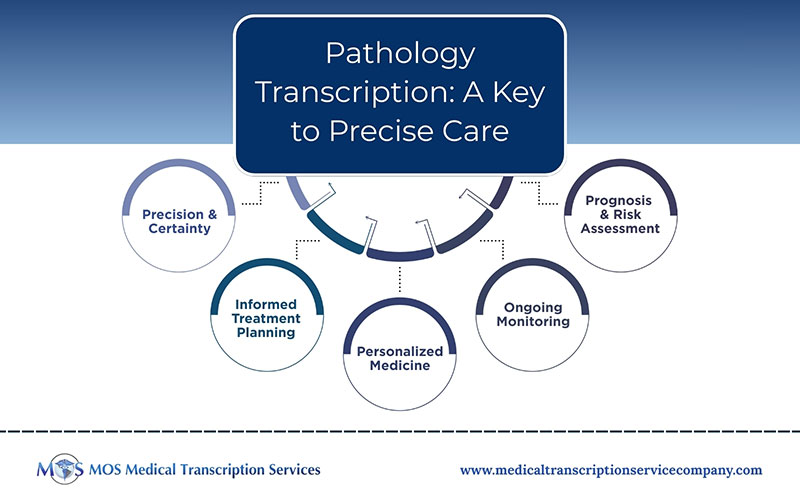
Table of Contents
- What is Accurate Pathology Transcription and Why Does It Matter?
- The Diagnostic Process: How Pathology Fits In
- Understanding Pathology Tests
- The Role of Transcriptions in Pathology
- The Power of Accurate Pathology Transcription in Diagnosis
- Key Areas Where Pathology Transcription Influences Care
- Pathology and Cancer Care: A Case Study in Accuracy
In modern healthcare, the role of pathology extends far beyond the simple study of disease. Pathology is the foundation of precise diagnosis and effective treatment, making it one of the most influential aspects of patient care. When paired with accurate pathology transcription, its impact becomes even greater. From detecting cancer in its earliest stages to guiding personalized treatment strategies, pathology ensures that medical decisions are based on reliable, evidence-driven insights. By integrating medical transcription services, healthcare providers can ensure that critical diagnostic information is recorded and communicated with the highest accuracy.
This post explores how accuracy in pathology reporting transforms diagnosis, influences treatment, and enhances patient outcomes.
What is Accurate Pathology Transcription and Why Does It Matter?
Pathology is the branch of medicine that focuses on studying tissues, cells, and bodily fluids to identify diseases. Accurate pathology transcription is essential for converting pathologists’ recorded notes, test results, and medical observations into precise, structured written documents without errors or omissions. Since pathology forms the foundation of many diagnoses and treatment plans, even the smallest transcription mistake can lead to misinterpretation, delayed care, or incorrect treatment. This is why accuracy is non-negotiable. By ensuring that every detail, such as specimen descriptions, lab findings, and diagnostic impressions, is documented correctly, accurate pathology transcription supports doctors and surgeons in making informed clinical decisions, reduces the risk of medical errors, and ultimately enhances patient safety and care outcomes. It also improves efficiency by providing clear, accessible reports that can be quickly referenced for coding, billing, and long-term medical records.
The Diagnostic Process: How Pathology Fits In
The path to a diagnosis involves multiple steps where pathology plays a vital role:
- Initial Evaluation – A patient first consults a healthcare provider for symptoms. If necessary, additional diagnostic tools such as imaging, blood tests, or biopsies are ordered.
- Sample Collection – Tissue or fluid samples are collected through procedures like endoscopy, biopsy, or surgery.
- Laboratory Analysis – Pathologists study these samples under a microscope. Advanced techniques such as staining, molecular testing, and genetic analysis reveal detailed disease characteristics.
- Diagnosis and Reporting – Pathologists prepare comprehensive reports describing the findings. These reports include the type of disease, stage, grade, and potential biomarkers, information critical for forming treatment strategies.
The reliability of these reports depends heavily on accurate pathology transcription. Even a minor error in documenting results can lead to misdiagnosis, delayed treatment, or inappropriate care plans.
Understanding Pathology Tests
Pathology tests involve analyzing samples such as blood, urine, or tissue. These tests detect infections, cancers, and chronic diseases.
- Clinical Pathology: Focuses on fluids like blood or urine, providing vital insights into infections, metabolic disorders, and systemic diseases.
- Anatomical Pathology: Examines tissues and organs to detect abnormalities such as tumors.
- Molecular Pathology: Studies genetic and molecular changes, often guiding targeted therapies in cancer treatment.
Pathology labs are the backbone of this work. Staffed by pathologists, scientists, and technicians, these labs are equipped with advanced technologies to ensure precision in testing and reporting.
The Role of Transcriptions in Pathology
While pathology analysis is highly technical, transcriptions ensure the findings are communicated accurately and clearly to treating physicians. Errors in transcription, whether numerical data, terminology, or patient identifiers, can have devastating effects.
Accurate pathology transcriptions:
- Eliminate ambiguity in medical reports.
- Support timely treatment decisions.
- Enhance collaboration among multidisciplinary care teams.
- Strengthen trust between patients and providers.
As healthcare embraces digital transformation, electronic medical records and diagnostic transcription services play a crucial role in ensuring accuracy and accessibility of pathology data.
The Power of Accurate Pathology Transcription in Diagnosis
- Precision and Certainty: Accuracy in pathology transcriptions ensure that no detail is lost in translation from lab analysis to clinical decision-making. For instance, in oncology, pathology distinguishes between tumor types, determines malignancy, and identifies molecular markers, all of which guide therapy.
- Informed Treatment Planning: Treatment strategies rely heavily on pathology reports. Identifying biomarkers in cancerous tissues, for example, can determine whether a patient is a candidate for targeted therapies. Inaccuracies in transcriptions could mean missing critical treatment opportunities.
- Prognosis and Risk Assessment: Pathologists provide information on disease progression, such as tumor stage or grade. This helps predict outcomes and guides the intensity of treatment. Clear, error-free pathology documentation ensures physicians receive the correct prognosis to counsel patients effectively.
- Ongoing Monitoring: Pathology is also central to evaluating treatment response. Follow-up biopsies and repeated tissue analysis show whether a tumor is shrinking, stable, or growing again. Consistent and precise transcription allows healthcare providers to adjust treatment quickly and appropriately.
- Personalized Medicine: Modern pathology incorporates molecular and genetic testing. By identifying unique patient-specific mutations, pathologists enable personalized treatment that improves effectiveness and minimizes side effects. Inaccurate reporting in these complex cases could derail customized care plans.

Key Areas Where Pathology Transcription Influences Care
- Early Detection and Diagnosis: Pathology transcription for accurate and timely diagnosis ensures that findings from histopathological examinations are clearly documented, enabling the identification of precancerous or early-stage conditions. This timely reporting supports early intervention and can significantly improve patient survival rates.
- Definitive Diagnoses: Many illnesses present overlapping symptoms, think of respiratory infections or autoimmune conditions. Medical transcription for pathology ensures the subtle differences revealed under a microscope are recorded clearly, providing the definitive answers clinicians need.
- Surgical Guidance: Intraoperative frozen sections provide surgeons with immediate insights during procedures. By transcribing these results accurately and swiftly, pathology transcription helps surgeons confirm tumor margins and make real-time decisions that enhance surgical outcomes.
- Research and Innovation: Pathology transcription also plays a vital role in medical research by preserving accurate records of findings. These transcriptions contribute to biomarker discovery, drug development, and clinical trial documentation—advancing medical knowledge and expanding treatment possibilities worldwide.
Pathology and Cancer Care: A Case Study in Accuracy
Cancer diagnosis and treatment illustrate how critical pathology is. Pathologists determine the cancer type, stage, and aggressiveness, then identify biomarkers that inform targeted therapy. During surgery, they confirm whether tumors have been fully excised. Afterward, they monitor treatment success by examining changes in tumor tissues.
Pathology is the foundation of modern diagnosis and treatment, but its effectiveness relies heavily on the accuracy of transcriptions. From early detection to personalized medicine, pathology provides the clarity and detail necessary for informed medical decisions. Every step depends on accurate transcription of findings. A missed mutation marker, incorrect tumor grade, or incomplete margin report could drastically change treatment decisions. This is exactly why transcription quality matters in pathology reporting.
Pathology transcriptions by a professional medical transcription company bridge the gap between laboratory findings and clinical care, ensuring that patients receive the right diagnosis, the right treatment, and the best possible outcomes.


